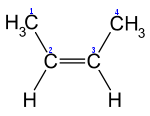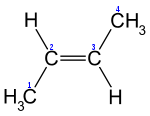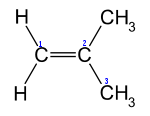- Butene
-
Butene (auch Butylene) sind eine Gruppe von vier isomeren Kohlenwasserstoffen mit der allgemeinen Summenformel C4H8, die über eine C–C-Doppelbindung verfügen. Sie zählen damit zu den Alkenen. Zwei der Isomere unterscheiden sich durch cis-trans-Isomerie.
Butene sind unter Standardbedingungen farblose, brennbare Gase mit einer größeren Dichte als Luft. Unter Druck lassen sich die Isomere verflüssigen. Sie wirken in höheren Konzentrationen narkotisierend und erstickend. Mit Luft bilden sie explosive Gemische.
Inhaltsverzeichnis
Struktur und Eigenschaften
Butene Name 1-Buten Z-But-2-en E-But-2-en 2-Methyl-1-propen Andere Namen n-Buten
1-Butylen
α-Butylen
But-1-encis-2-Buten
Z-2-Buten
cis-But-2-entrans-2-Buten
E-2-Buten
trans-But-2-enIsobuten
i-ButylenStruktur 



CAS-Nummer 106-98-9 590-18-1 624-64-6 115-11-7 Summenformel C4H8 Molare Masse 56,11 g·mol−1 Kurzbeschreibung farblose Gase Schmelzpunkt −185,3 °C −138,9 °C −105,5 °C −140,4 °C Siedepunkt −6,26 °C 3,72 °C 0,88 °C −6,9 °C Verdampfungswärme am Siedepunkt 22,07 kJ·mol−1[1] 23,34 kJ·mol−1[1] 22,72 kJ·mol−1[1] 24,03 kJ·mol−1[2] Dampfdruck 2,545 bar (20 °C) 1,813 bar (20 °C) 1,991 bar (20 °C) 2,59 bar (20 °C) Untere Explosionsgrenze (20 °C / 1,013 bar)[3] 1,2 Vol% / 28 g·m3 1,6 Vol% / 37 g·m3 1,6 Vol% / 37 g·m3 1,6 Vol% / 37 g·m3 Obere Explosionsgrenze (20 °C / 1,013 bar)[3] 10,6 Vol% / 252 g·m3 10,0 Vol% / 235 g·m3 10,0 Vol% / 235 g·m3 10,0 Vol% / 235 g·m3 Zündtemperatur / Temperaturklasse[3] 360 °C / T2 n.b n.b 465 °C / T1 Löslichkeit praktisch unlöslich in Wasser, leichtlöslich in Ethanol und Ether Gefahrstoffkennzeichnung
(Gilt für alle Butene) [4]
Hoch-
entzündlich(F+) R- und S-Sätze: R: 12
S: (2)-9-16-33GHS-
Einstufung
(Gilt für alle Butene) [4]
Gefahr

H- und P-Sätze: H: 220
P: 210-377-381-403[5]Thermodynamische Eigenschaften
Butene sind leicht zu verflüssigende Gase, deren Anwendung und Umsetzung oft unter erhöhtem Druck als Flüssigkeit oder im überkritischen Zustand erfolgt.
Dampf-Flüssig-Gleichgewichte Name 1-Buten Z-But-2-en E-But-2-en 2-Methyl-1-propen Dampfdruckfunktion nach Antoine Parameter nach log10(P) = A−(B/(T+C)) (P in bar, T in K) A 4,24696 3,98744 4,04360 3,64709 B 1099,207 957,060 982,166 799,055 C −8,265 −36,504 −30,775 −46,615 Temperaturbereich 195,6 K – 269,4 K 203,06 K – 295,91 K 201,70 K – 274,13 K 216,40 K – 273 K Quelle [6] [7] [8] [9] Kritische Größen[10] Name 1-Buten Z-But-2-en E-But-2-en 2-Methyl-1-propen Kritische Temperatur Tc 146,35 °C / 419,5 K 162,35 °C / 435,5 K 155,45 °C / 428,6 K 144,75 °C / 417,9 K Kritischer Druck pc 40,2 bar 42,1 bar 41,0 bar 40,0 bar Kritisches Molvolumen Vm,c 0,2408 l·mol−1 0,2338 l·mol−1 0,2377 l·mol−1 0,2388 l·mol−1 Kritische Dichte ρc 4,15 mol·l−1 4,28 mol·l−1 4,21 mol·l−1 4,19 mol·l−1 Synthese
Michael Faraday fand Butene 1825 als gasförmigen Bestandteil bei der Destillation von Erdöl (siehe auch: Flüssiggas). Butene können durch Cracken von Erdöl als Isomerengemisch gewonnen werden. Sie werden auch durch thermische Reaktion (Dehydrierung) von n-Butan bzw. Isobutan gewonnen.
Verwendung
Durch die C-C-Doppelbindung sind sie interessante und wichtige Ausgangsstoffe für chemische Synthesen. Sie werden zur Herstellung von Verbindungen wie 2-Butanol, 2-Butanon (durch Oxo-Synthese) und 1,3-Butadien verwendet und sind Ausgangsstoff zur Herstellung von Kunststoffen (z. B. Butylkautschuk und Polyisobuten). Als Alkylierungsmittel dienen sie z. B. zur Synthese von Zusätzen für klopffeste Treibstoffe (2,2,4-Trimethylpentan (Isooctan)). Isobuten wird zur Synthese von Methyl-tert-butylether (MTBE) bzw. Ethyl-tert-butylether (ETBE) benötigt. Auch tert-Butylester lassen sich über die Reaktion von Isobuten und (Carbon)säuren herstellen. Diese Syntheseroute bietet sich speziell dann an, wenn bei der Veresterung mit tert-Butanol als Konkurrenzreaktion dessen Dehydratisierung dominiert.
Einzelnachweise
- ↑ a b c Majer, V.; Svoboda, V.: Enthalpies of Vaporization of Organic Compounds: A Critical Review and Data Compilation, Blackwell Scientific Publications, Oxford, 1985, S. 300.
- ↑ Weast, R.C. (Ed.): CRC Handbook of Chemistry and Physics, 66th Edition, CRC Press Inc 1985, ISBN 0-8493-0466-0.
- ↑ a b c E. Brandes, W. Möller: Sicherheitstechnische Kenngrößen - Band 1: Brennbare Flüssigkeiten und Gase, Wirtschaftsverlag NW – Verlag für neue Wissenschaft GmbH, Bremerhaven 2003.
- ↑ a b Eintrag zu CAS-Nr. 106-98-9 im European chemical Substances Information System ESIS.
- ↑ Eintrag zu CAS-Nr. 106-98-9 in der GESTIS-Stoffdatenbank des IFA, abgerufen am 27. April 2011 (JavaScript erforderlich).
- ↑ Coffin, C.C.; Maass, O.: The Preparation and Physical Properties of «alpha», «beta»- and «gamma»-Butylene and Normal and Isobutane, in: J. Am. Chem. Soc., 1928, 50, S. 1427–1437.
- ↑ Scott, R.B.; Ferguson, W.J.; Brickwedde, F.G.: Thermodynamic properties of cis-2-butene from 15° to 1,500 K, in: J. Res. NBS, 1944, 33, S. 1–20.
- ↑ Guttman, L.; Pitzer, K.S.: trans-2-Butene. The heat capacity, heats of fusion and vaporization, and vapor pressure. The entropy and barrier to internal rotation, in: J. Am. Chem. Soc., 1945, 67, S. 324–327.
- ↑ Lamb, A.B.; Roper, E.W.: The Vapor Pressures of Certain Unsaturated Hydrocarbons, in: J. Am. Chem. Soc., 1940, 62, S. 806–814.
- ↑ Tsonopoulos, C.; Ambrose, D.: Vapor-Liquid Critical Properties of Elements and Compounds. 6. Unsaturated Aliphatic Hydrocarbons, in: J. Chem. Eng. Data, 1996, 41, S. 645–656.
Kategorien:- Feuergefährlicher Stoff
- Stoffgruppe
- Alken
Wikimedia Foundation.
